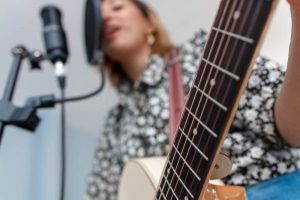One of the most frustrating concepts to new guitarists are bar chords, also known as barré chords in classical guitar terminology. These tricky chords have been annoying guitarists for generations, and many players are tempted to avoid all music that includes them. However, bar chords are extremely useful and they offer a beautiful sound to your guitar. The knowledge of these chords can also help you find any major and minor chord on the guitar! So, what is a bar chord, how do we play these chords comfortably without injury, and how are these useful in guitar music?
What is a Bar Chord?
A bar chord is a unique way of playing a chord where we use our index finger to press and hold 2 or more strings at the same time. When people talk about bar chords, we tend to think of full bar chords, which is where we hold all 6 strings with our index. Our index finger literally acts as a “bar” across an entire fret!
Prerequisites and Tips Before Starting
Before attempting bar chords, I strongly recommend you become proficient in your basic major and minor chords. If you can switch between all of your standard chords with ease, then you are ready to tackle bar chords. I also recommend learning the musical alphabet before attempting these. Here are the chords you should be familiar with…
Major Chords: C, A, G, E D
Minor Chords: Am, Dm, Em
Before starting to play bar chords, keep these 3 rules in mind…
- STRETCH BEFOREHAND! We want to make sure our hands are warmed up so we do not pull or strain a muscle.
- If you feel incredible amounts of tension or pain, STOP! Do not force these chords right away! If you feel pain or tension in your hands, go ahead and stretch again to decrease your risk of injury.
- Only practice these chords for 5-10 minutes a day when first starting! Practicing these chords for long periods of time as a beginner is exhausting!
When you are ready, let’s get started!
How to Play Bar Chords Without Injury
I said it once and I’ll say it again; PLEASE STRETCH BEFORE, DURING, AND AFTER PRACTICE! Take your time with this process and do not worry if these chords don’t develop right away! This skill is using muscles in your hand you have never used before in your life, so be gentle with them. Here are my steps to playing bar chords easily…
Your first Bar Chord: F Major
The most common bar chord you will be playing is F Major. Here is a chord diagram to help you. We bar the first fret and have what looks like an E Major chord shape underneath! Try it!
How to find Major and Minor Chords
Now that you understand F Major, let’s find other major/minor chords! If you know your musical alphabet, this concept will be easy for you! Here is the alphabet using sharps…
A A# B C C# D D# E F F# G G#
Let’s say I want you to play an F# Major chord now. All you have to do is take the F Major bar shape, and slide it to the 2nd fret! G Major bar chord? Slide that shape to the 3rd fret! Want to make those chords minor? Take your middle finger off the G string so your fingers under the bar look like an Em chord shape! Pretty easy right? Think of your index like it’s a capo!
What about 5 string bar chords that start on the A string? Same concept! If we want to make a major 5 string bar chord, we bar the fret we want and use our other fingers to hold an A Major chord shape. Want to make that same chord minor? Use your fingers to make an Am shape instead! We are using our previous knowledge of introductory chords to find all of these different chord voicings!
Need extra help with this topic? Check out this free 22-minute video I made for my former high school students on bar chords!
Zach Deyo

